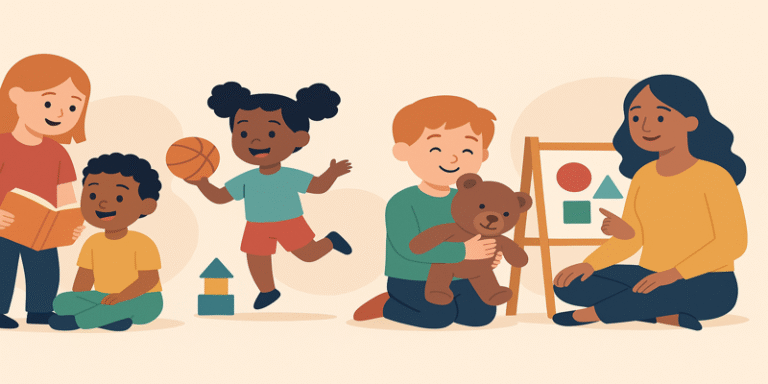Early childhood, typically defined as the period from three to five years old, is one of the most formative stages in human development. During this time, children undergo rapid cognitive, emotional, social, and physical transformations, shaping their future learning and behaviour. These years are often referred to as the preschool stage, a time when the brain is especially plastic and responsive to environmental stimuli (Shonkoff & Phillips, 2000). Understanding the key developmental milestones during this period is crucial for parents, educators, and healthcare professionals to support children’s optimal growth and identify delays early.
1.0 Cognitive Development
Between ages 3 and 5, children experience a dramatic expansion in cognitive abilities, particularly in language, memory, and symbolic thought. According to Piaget’s preoperational stage, children in this age group start to use symbols to represent objects, though their thinking remains egocentric and concrete (Berk, 2013).
A study by Lee, Flouri & Jackson (2025) found that executive functions, such as working memory and impulse control, begin developing in tandem with increasing complexity in children’s play and problem-solving activities. These cognitive processes are linked to school readiness and future academic achievement. Additionally, research on linguistic labels and inductive reasoning by Liang et al. (2025) demonstrates how preschoolers begin to understand categories and generalisations, marking a critical shift in logical reasoning.
2.0 Language and Communication
Language development is often one of the most visible domains of growth during preschool years. Children progress from using short phrases at age three to complex sentences by age five (Whitebread, 2012). Research by Goel et al. (2025) highlights the influence of breastfeeding duration on the attainment of language milestones, suggesting a complex interplay between nutrition, caregiving, and language development.
By age five, most children can:
- Follow multi-step instructions
- Use past and future tense correctly
- Ask and answer “why” questions
- Engage in sustained conversations (Trimmis et al., 2025)
Additionally, linguistic development is influenced by cultural and social factors, including exposure to storytelling, parental interaction, and play-based curricula (Gross et al., 2025).
3.0 Social and Emotional Development
Social and emotional growth in early childhood lays the foundation for empathy, self-regulation, and interpersonal relationships. Children begin to identify emotions, take turns, and resolve conflicts. A qualitative shift also occurs in their sense of identity, often seen through imaginative play and role-taking (Berk & Meyers, 2018).
Perez (2025) developed a range of social-emotional activities aimed at reducing problematic behaviours in preschoolers, illustrating that targeted interventions during this phase can foster emotional resilience. Similarly, Loeffler (2024) explored the impact of nap cessation, finding it significantly correlated with increased self-regulation and peer interaction quality.
Furthermore, the RSA reactivity model (Lee, Flouri & Jackson, 2025) links physiological responses to emotional stimuli with developmental delays, providing early biomarkers for socio-emotional challenges.
4.0 Physical and Motor Skills
Physical development in this age group includes both gross motor skills (e.g., running, jumping) and fine motor skills (e.g., drawing, buttoning clothes). These skills are often used as developmental benchmarks. According to Mushaphi et al. (2024), the nutritional status of children in early childhood directly influences the acquisition of motor milestones, such as balance, coordination, and hand-eye coordination.
By age five, most children can:
- Hop on one foot
- Draw basic shapes
- Use scissors safely
- Dress and undress independently (WHO, 2023)
The role of outdoor play and free movement cannot be overstated, as they promote not only physical development but also support neurological maturation and spatial awareness (Whitebread, 2012).
5.0 The Role of Environment and Socioeconomic Factors
Developmental outcomes during early childhood are closely tied to environmental influences. A large-scale Brazilian study (Freitas-Costa et al., 2025) linked factors such as household income, maternal education, and access to early childhood education with disparities in milestone attainment.
In South Africa, Charge et al. (2025) developed a context-specific ECD milestone guide for practitioners, emphasising the importance of tailoring developmental expectations to local realities. This approach is crucial for reducing developmental inequities in diverse settings.
Home environments rich in verbal interaction, nutritional support, and responsive caregiving have been shown to significantly enhance developmental trajectories (Shonkoff & Phillips, 2000; UNICEF, 2022).
6.0 Health and Developmental Screening
Routine developmental screening is essential during the preschool years. Delays in speech, motor skills, or emotional regulation can be early signs of developmental disorders such as Autism Spectrum Disorder (ASD) or Attention Deficit Hyperactivity Disorder (ADHD) (CDC, 2024).
Screening tools such as the Ages and Stages Questionnaires (ASQ) and Denver Developmental Screening Test provide standardised ways of tracking developmental progress. Early identification allows for timely interventions, significantly improving long-term outcomes (BMJ Public Health, 2025).
7.0 Cultural and Linguistic Diversity in Development
Developmental milestones are universal, but cultural context influences the way children achieve them. Trimmis et al. (2025) investigated the usage of parts of speech in Greek-speaking children and found cultural-linguistic variations in the sequence and timing of language milestones. Similarly, Liang et al. (2025) showed that inductive reasoning can be shaped by both linguistic labels and object types, highlighting the influence of language structure on cognitive development.
Educators and practitioners must adopt a culturally responsive approach, recognising that variations in development are not always indicative of delay but may reflect normative differences across communities.
The early childhood period, especially from ages 3 to 5, is a time of profound growth across multiple domains. Developmental milestones provide a roadmap to understanding this growth, enabling timely support and intervention. A comprehensive understanding of these milestones—grounded in evidence-based research, culturally sensitive practices, and holistic approaches—ensures children are given the best possible start in life.
References
Berk, L. E. (2013). Child Development (9th ed.). Pearson Education.
Berk, L. E. & Meyers, A. B. (2018). Infants, Children, and Adolescents (8th ed.). Pearson.
Charge, K. et al. (2025). Developing a contextually relevant ECD milestone guide. South African Journal of Childhood Education, [Online] Available at: https://sajce.co.za/index.php/sajce/article/view/1700
Freitas-Costa, N. C. et al. (2025). Factors associated with early childhood development. BMJ Public Health, 3(1), e001516. https://bmjpublichealth.bmj.com/content/3/1/e001516
Goel, M. et al. (2025). Breastfeeding and language milestones. Children, 12(6), 719. https://www.mdpi.com/2227-9067/12/6/719
Gross, R. S. et al. (2025). Long COVID Symptoms and Early Development. JAMA Pediatrics. https://jamanetwork.com/journals/jamapediatrics/article-abstract/2834480
Lee, J. J., Flouri, E. & Jackson, Y. (2025). RSA Reactivity in Preschool Development. Developmental Psychobiology. https://onlinelibrary.wiley.com/doi/abs/10.1002/dev.70042
Liang, Y. et al. (2025). Inductive reasoning in Chinese preschool children. Infant and Child Development. https://onlinelibrary.wiley.com/doi/abs/10.1002/icd.70033
Mushaphi, L. F. et al. (2024). Nutritional status and milestone development. FAO AGRIS. https://agris.fao.org/records/6765a3976784547a43e38e74
Perez, M. (2025). Social-Emotional Activities for Preschoolers. Medical University of South Carolina. https://medica-musc.researchcommons.org/muscotd-elotd/55/
Shonkoff, J. P. & Phillips, D. A. (2000). From Neurons to Neighborhoods: The Science of Early Childhood Development. National Academy Press.
Trimmis, N. et al. (2025). POS development in Greek-speaking preschoolers. Neuroscience Research Notes. https://neuroscirn.org/ojs/index.php/nrnotes/article/view/384
UNICEF. (2022). Early Childhood Development Overview. https://www.unicef.org/early-childhood-development
Whitebread, D. (2012). Developmental Psychology and Early Childhood Education. SAGE.









